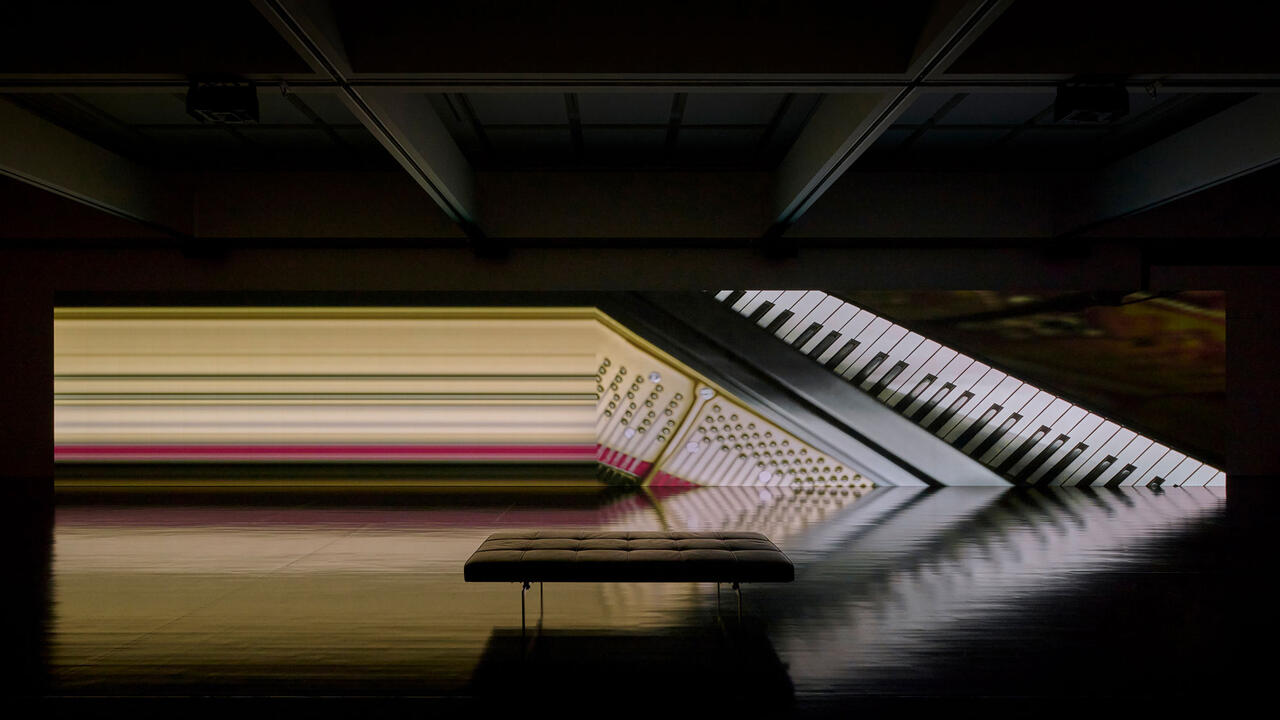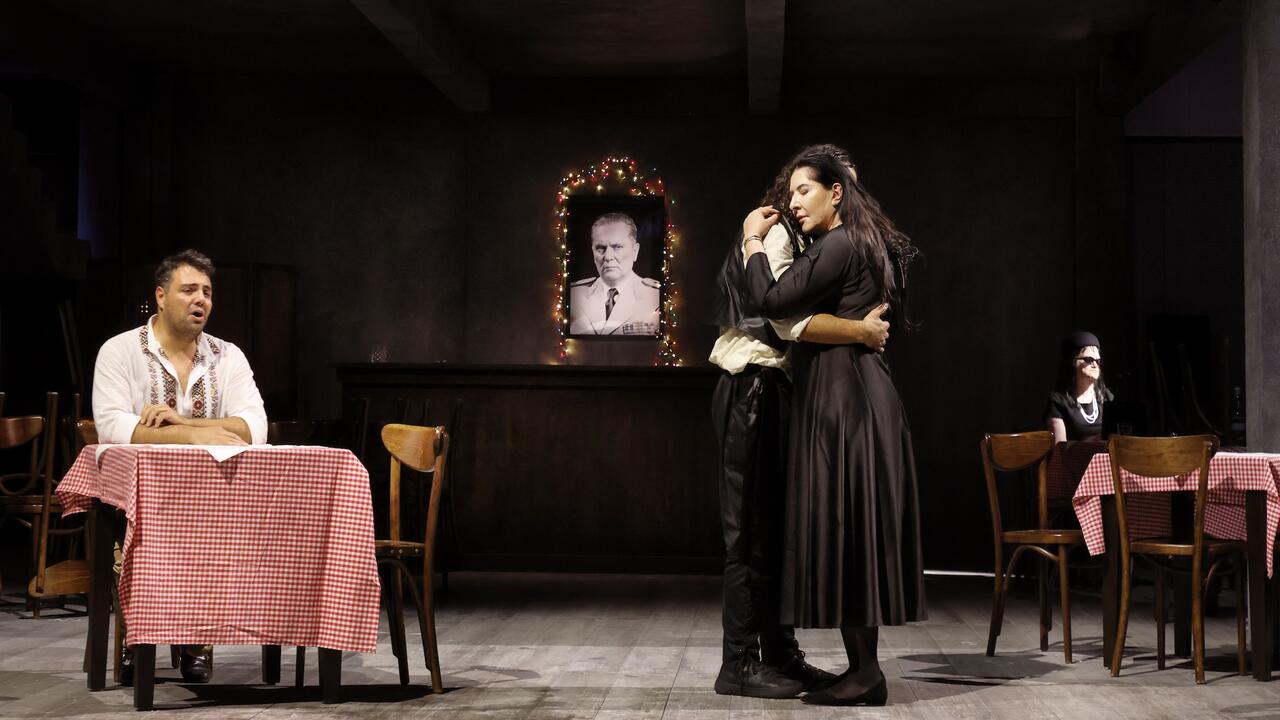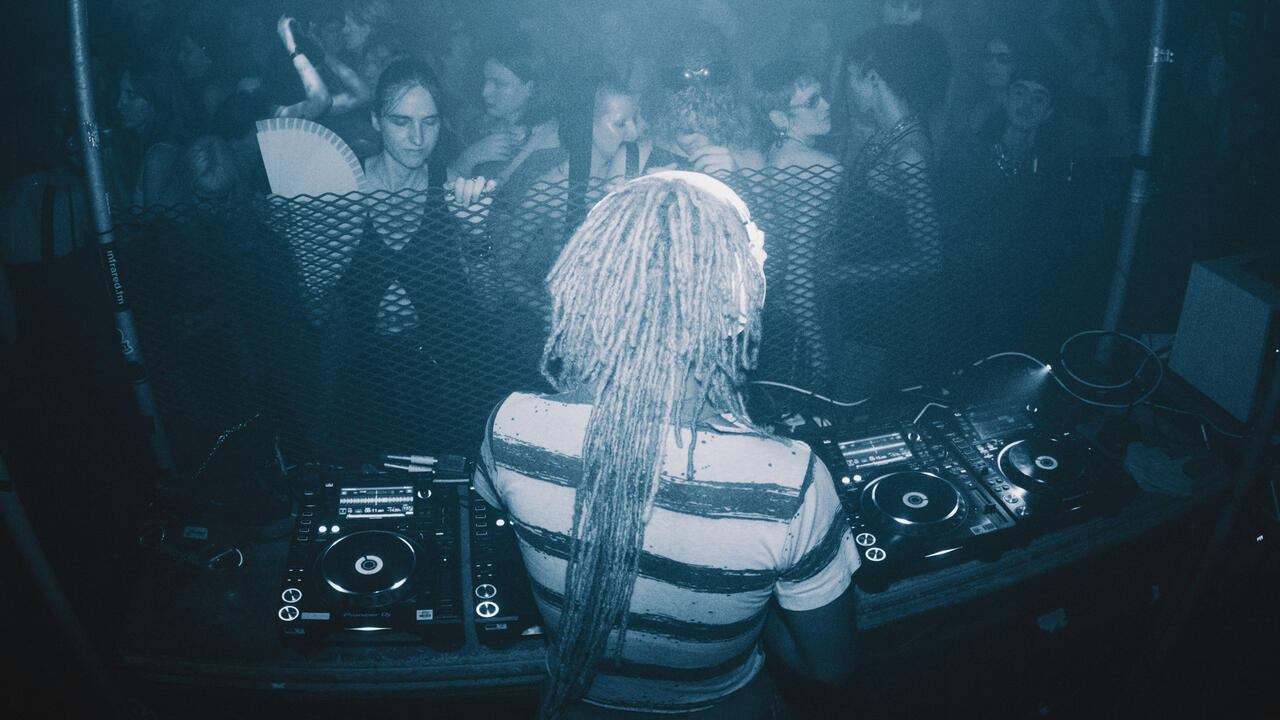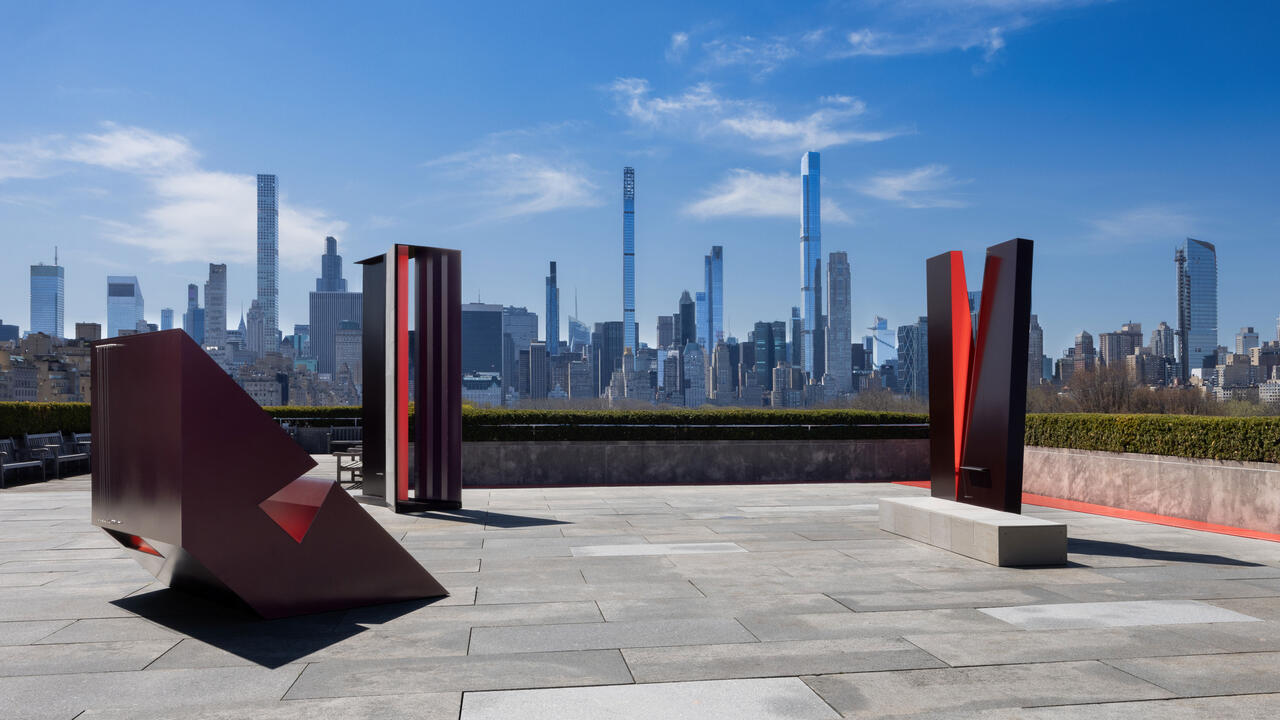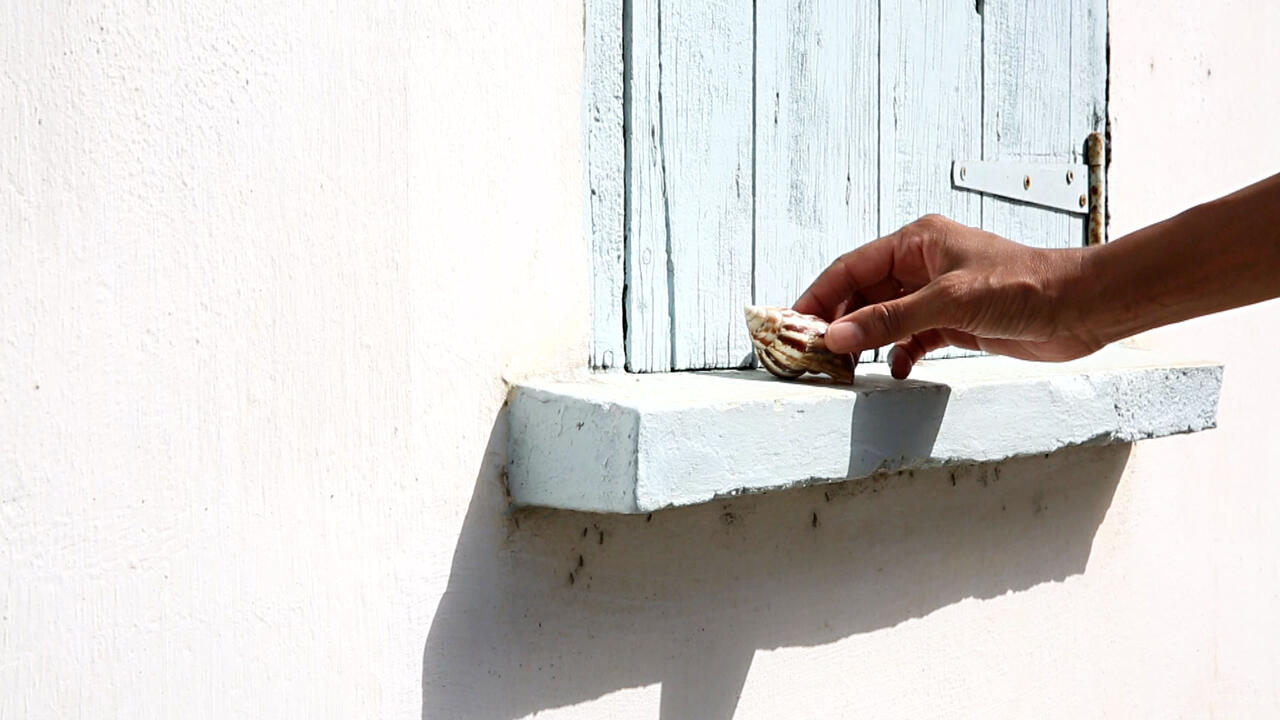Jay Z, The Art of Noise and Afrika Bambaataa
Why pop music craves art’s pieties and licensed intellectualism and art lusts after music’s broader cultural authenticity
Why pop music craves art’s pieties and licensed intellectualism and art lusts after music’s broader cultural authenticity

It’s a soup-hot July in New York. I am pressed against spongy, off-white sound proofing which lines the walls of the Pace Gallery in Chelsea. To my left is a throng of people jammed into a narrow cordoned-off area around the edge of the space. On my right, a security guard politely tells me that if I move any further in his direction I will be ‘in everyone’s way’. New York art stars, power-administrators, taste arbiters, collectors and entertainment industry types fill the gallery. Outside, kids dressed to the nines queue to get in next to vips, don’t-you-know-who-I’m-friends-with VIPs, and cogs in the art machine – such as me. There are people here who look moneyed, expensively moisturized, fresh out of a Ralph Lauren campaign advertising the consolations of wealth, or maybe a Young Patrons wine-cheese-and-curator-lecture event at an uptown museum. The culturally significant or wealthy, or both, are ushered in by vip-wranglers, all smiling ‘so awesome to see yous’ to their guests and efficient ‘these people need to come throughs’ to the rest of us in steerage class.
Jay Z might describe these people as the type that own a ‘house like the Louvre or the Tate Modern’. Jay Z is, in fact, the reason I am here. It’s the video shoot for his track ‘Picasso Baby’, a song which admits contemporary art past the red vip rope and into the lexicon of hiphop commodity fetishism – ‘I’m the new Jean-Michel / Surrounded by Warhols / My whole team balls / Twin Bugattis outside the Art Basel’ – and must be the only instance of the name ‘Rothko’ being uttered in the same breath as the word ‘brothel’. Sampling being at the philosophical core of hiphop, the concept for the Mark Romanek-directed video shoot is a borrowed one, taken from Marina Abramović’s marathon performance The Artist is Present (2010), for which members of the public sat in front of Abramović to gaze into her eyes, an experience that – possibly due to the pseudo-religious theatre of the event – reduced some participants to tears or proposals of marriage.
Jay Z’s interpolation involves rapping ‘Picasso Baby’ for a straight six-hours from a low plinth in the centre of Pace. In front of his riser is a bench visited by a constant stream of celebs and New York art-world notables, to whom Jay Z raps for a couple of verses. But this being a video shoot – or, rather, this being a video shoot for one of the world’s biggest stars, its execution thus requiring the logistical chops of a four-star general – for most of Jay Z’s six-hour stint he is not performing continuously at all, but taking breaks backstage whilst the production crew crowd-manage the audience.
So we wait. The event couldn’t be more perfectly Warholian, or at least representative of a perfectly New York triangulation of art, celebrity and business. It reminds me that Jay Z is not the first musician to have embraced modern art in pop lyrics. David Bowie’s ‘Andy Warhol’ (1971) paid tribute to his hero, though when Bowie first visited the Factory, the meeting was reportedly uncomfortable. The Modern Lovers observed that Jay Z’s beloved Picasso never got called an asshole. Eventually, Jay Z arrives. He comes across as relaxed, affable, courteous; his performance is, however, oddly plain. As art/pop crossovers go, it’s not exactly Leigh Bowery prancing in front of The Fall, or Jean-Michel Basquiat chancing upon Melle Mel in Downtown 81 (1981/ 2000). The power of spectacle here lies in the fact of celebrity, rather than imagination. Jay Z does a few run-throughs of the track: ‘I wanna row of Christie’s with my missy / Live at the MOMA …’
Oh yeah, the MOMA. As it happens, on the morning of the Jay Z shoot I receive an email from the museum’s press office. It announces an exhibition titled ‘Soundings’ which is described as ‘MOMA's first exhibition to treat sound as a form of artistic expression’. Cynically, I imagine shuffling avant-noiseniks gratefully doffing their caps outside the museum doors. ‘Thank you MOMA! We always hoped our sounds were a form of artistic expression and, thanks to your benediction, we can finally find acceptance!’ But still, what took them so long?
I wonder if MOMA chose 2013 for ‘Soundings’ to keep the art-historical borders neatly trimmed. This year happens to be the centenary of L’Arte dei rumori (The Art of Noises), a letter-cum-manifesto written by Futurist Luigi Russolo to his friend, the composer Francesco Balilla Pratella, which argues that the human ear needed new sounds to compliment the speed and technology of the 20th century. Whatever MOMA's reasons, the Jay Z shoot feels a long way from Russolo, but something tells me I’ve seen Futurism and hiphop together before.
This month is also the 30th anniversary of the 12-inch EP Into Battle with The Art of Noise, which was released on the ZTT label. ZTT stands for ‘Zang Tuum Tumb’, taken from Filippo Tommaso Marinetti’s 1914 Futurist sound poem, while the band’s name – The Art of Noise – was a play on the title of Russolo’s manifesto. The original members comprised Gary Langan, J.J. Jeczalick, Trevor Horn, Anne Dudley and writer Paul Morley, who in 1983 was also busy conceptualizing Frankie Goes to Hollywood’s image campaign. Morley parlayed hyper-literate references to avant-garde art into The Art of Noise, through their graphic identity and enigmatic liner notes. It was, in a sense, an experiment to see what would happen when the cultural authority of art history was put at the service of pop music; in a sense, not too far removed from Jay Z’s ‘Picasso Baby’, minus the acquisitiveness.
Into Battle … features a detail from the 15th-century Ghent Altarpiece on its cover, and the band’s image – at least for the first few years of its existence – was to remain anonymous, hidden behind images of neo-classical statuary, nods to Surrealist photography and cryptic texts. The ep featured two principal tracks, ‘Beat Box’ and ‘Moments in Love’, escorted by seven short variations and reprises. One of the earliest records to be made using the Fairlight CMI sampling synthesizer, Into Battle … is a cut ‘n’ paste collage of heavy-duty industrial beats, working in machine-like concert with vocal, orchestral and film samples. Precise and piston-like, ‘Beat Box’ is oiled by funk and humour (the sound of bubbles underwater and a car ignition are amongst the samples used), whereas ‘Moments in Love’ is slow and stately; the principal melody line a sad, fuzzy four-note orchestral sample, contrasting in tone and texture with a cut-glass synth bass-line. A single version of ‘Beat Box’ reached number one in the us dance charts in 1984 and subsequently became a hugely influential early hiphop track, with, ironically, the faceless all-white band being awarded ‘Best Black Dance Act 1984’ by Billboard magazine.
The day after Jay Z’s video shoot, I visit Gavin Brown’s enterprise to see The Afrika Bambaataa Master of Records Open Archive. Organized by Johan Kugelberg/Boo-Hooray Gallery, together with Afrika Bambaataa, the Universal Zulu Nation and Cornell University Library, this one-month project allows visitors to see the process of cataloguing the entire record collection of hiphop pioneer dj Afrika Bambaataa before it is donated to The Cornell Hip-Hop Collection this autumn. In the gallery at GBE, stacked white archive boxes packed with vinyl weigh heavy on trestle tables. There are no art celebs or minor league actors mugging for the camera here. Just boxes mutely representing years of creative close listening; a vast range of musical genres, the track titles on each sleeve carefully annotated and rated by Bambaataa. Does a copy of The Art of Noise’s Into Battle … sit in one of these boxes? Where else might Morley and Co’s visual appropriations of 20th-century Modernism have exerted their secret influence?
The effects of placing the complex socio-cultural histories and economies of pop music (specifically hiphop in its New York City birthplace) inside that of contemporary art are tangled to say the least. Histories of race colliding with the changing social make-up of the city is one thing, and the fascination between visual art and pop music grows ever-more complex as the economic models and cultural authority of both ebb and flow. It’s an old romance but still a torrid mess of mutual desire. Pop music craves art’s pieties, its licensed intellectualism, its spaces of relative open-mindedness and, most recently, its unique commodity value. Art lusts after music’s broader cultural authenticity and legitimizing popularity, where conversations about qualities such as pleasure are not policed with quite the same flagellant fervour as they are in the art field. And as everyone’s giddy excitement at the Jay Z shoot demonstrates, bona-fide pop celebrity trumps the big fishes in art’s small pond who are easily flattered by lyrics about George Condo and Jeff Koons.
Reviewing the European moderne seriousness of the compilation album From Brussels with Love in the NME in 1980, Morley argued: ‘It’s pop/art. Insufferably over-fashionable, lavishly over the top, dreadfully dilettantish, finely eclectic. Pop can be so many things.’ So can art. It can be painting, performance, publishing, video, architecture, film, music, sound, social outreach, sculpture, printmaking, broadcast, installation, conversation, education, theatre, dance, design, philosophy, cookery. Art today demonstrates a voracious appetite for other disciplines and subjects. It has developed criteria (some would say dark arts of casuistry) for justifying these appetites. Jay Z can appropriate Abramović’s work, but he’s not going to be taken seriously in October. Then again, pop is perfectly adept at its own jurisprudence; for all the flirting, Jay Z doesn’t need curators or critics any more than The Art of Noise or Bambaataa do. Different cultural currencies are being traded here, but we need to recognize which way the exchange rate is weighted.










